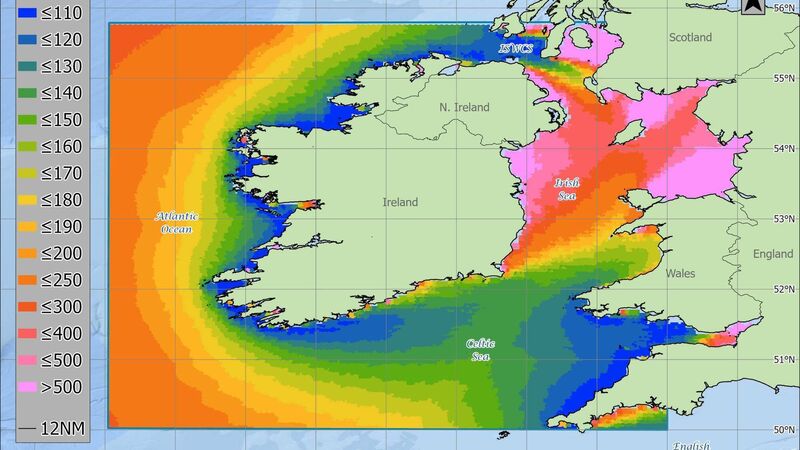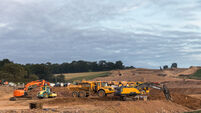Wave energy potential off Ireland is huge

A figure from the diagram pictured above right, maps the levelized cost of wave energy off Ireland and the UK.
IRELAND is now emerging as a hub for Offshore Renewable Energy (ORE), with offshore wind recently taking centre-stage due to the proven commercial readiness of fixed offshore wind technology.
However, fixed offshore wind will not be suitable in all locations off our coast and if Ireland is to reach its ambitious target of net zero emissions by 2050, a mix of ORE solutions will be required.
In the shadows of offshore wind lately, somewhat forgotten about is the enormous potential for wave energy off our shores. The resource is particularly abundant off our Atlantic and Celtic Sea facing coasts.
The main reason wave energy has recently been overlooked, is the immaturity of the technology in comparison to offshore wind and the perception that it will not be a viable alternative anytime soon. However, the technology is now fast progressing.
An Irish wave energy technology developer, Ocean Energy based here in Cork, will soon test a scaled-up wave energy device in Scotland. The Cobh-registered company will trial their OE35 Wave Energy Converter (WEC) in open sea conditions at the European Marine Energy Centre (EMEC) in the Orkney Islands.
Meanwhile, Swedish based CorPower Ocean’s WEC is undergoing full-scale testing in the Atlantic Ocean off Portugal. CorPower estimate that a farm comprising their WEC technology will generate more electricity per square kilometre of ocean than an offshore wind farm with the same geographical footprint.
With technology evidently maturing, there are now plans for a full-scale wave energy demonstration project off the west coast of Ireland by the end of this decade. The 5MW ‘Saoirse’ project, which is being developed by ESB and Cork’s Simply Blue Group, will use CorPower Ocean’s WEC technology in a pre-commercial array off Clare once sea trials in Portugal are complete. This will pave the way for future scaled-up commercial arrays elsewhere in Ireland into the 2030s.
With Cork’s massive coastline (approx. 1,200km) straddling both the Atlantic Ocean and Celtic Sea, it may come as no surprise that ours is a wave energy resource as plentiful as any.
The seas off Cork’s coast are also quite deep, particularly to the southwest. Similar to Floating Offshore Wind (FLOW), most wave energy devices can be deployed at depths beyond those at which fixed offshore wind becomes unviable (approx. >60m). With visual impact and supply chain issues an expected future challenge for FLOW in Ireland, wave energy holds the advantage of having almost no visual impact and requiring less port infrastructure for deployment in comparison to FLOW.
A recent scientific paper from MaREI at UCC has also indicated that the feasibility of commercial scale wave energy farms could be on par with that of FLOW if deployed in the right places, including Cork.
A figure from the diagram pictured top above, maps the levelized cost of wave energy off Ireland and the UK. This shows areas of highest feasibility in blue (lowest levelized cost) evidently hugging Cork’s coastline, particularly down along West Cork.

Renowned for its spectacular Wild Atlantic Way coastline, visual impact may be of particular significance in the nearshore areas of places like West Cork, thus indicating that wave energy may be a better option here than offshore wind. Furthermore, the possibility for a domestic supply chain utilising local ports and harbours could create jobs in remote coastal communities suffering from a declining fishing industry in recent years.
Further out to sea, where visual impact is less of a concern, there is also the prospect of combined offshore wind and wave energy arrays, a potentially good option for Cork given the abundant wind energy resource which also exists off our coast.
The concept, which acknowledges the often asynchronous relationship between wind and wave energy resource availability, is one where WEC devices could produce energy when wind power production is low, i.e. on a calm day when there is still a significant swell out at sea.
Whichever the concept, utilizing the natural forces of the ocean could revolutionise our region’s energy landscape, providing us with a consistent and reliable source of clean energy and reducing our reliance on imported fossil fuels, whilst also having a positive impact on our coastal communities.
The development of wave farms off our coast would not only promise to create new job opportunities and stimulate rural economic growth but would also demonstrate Cork’s maritime embrace.
As the world shifts toward renewable energy solutions, County Cork has an opportunity to become a leader in wave energy harnessing, with offshore arrays powering our homes and businesses onshore in a more sustainable and energy secure future for the next generation.
Ross O’Connell is a Post-Doctoral Researcher at MaREI, the SFI Research Centre for Energy, Climate and Marine, coordinated by the Environmental Research Institute (ERI) at University College Cork.







 App?
App?




